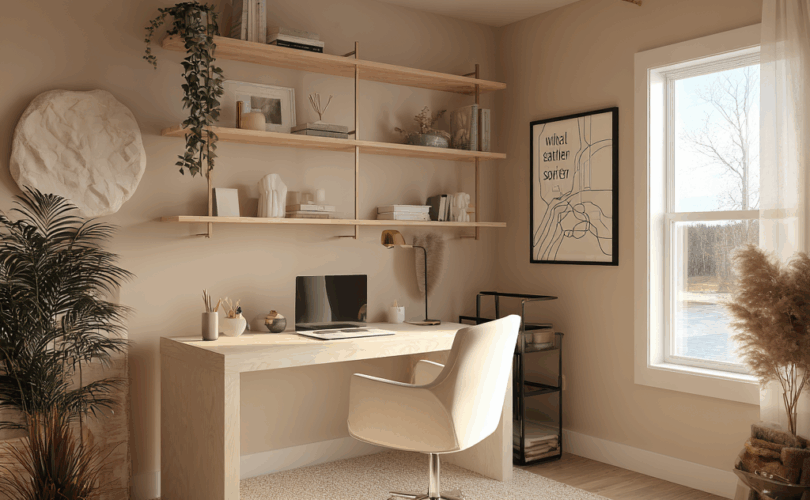You do not need more space.
You need more clarity.
This post is for the woman buried in sticky notes, late-night tabs, and a desk that silently screams “emergency.” Whether you’re running your empire from the corner of your kitchen or the quietest room in your house, your environment is either activating your genius—or draining it.
Here’s the real truth:
Your workspace is not just a place. It’s a mirror of your mind.
And if your space is chaotic, so is your focus, your income flow, and your energy.
Let’s clean that up. Strategically.
The Real Problem: Your Office Is Making You Tired
We’ve been trained to associate productivity with doing more, buying more, building more.
But neuroscience says otherwise.
According to Princeton University’s Neuroscience Institute, visual clutter competes for your attention and reduces your cognitive performance. (McMains & Kastner, 2011)
Translation:
That pile of mail?
Those tangled cords?
That one drawer you avoid opening?
They’re stealing your focus—quietly, daily, completely.
Why This Matters (Especially for Women of Color & Caregivers)
Black women, caregivers, and multitasking creatives are carrying more invisible labor than ever. You are already managing:
-
Emotional load
-
Mental tabs
-
Family needs
-
Financial strategy
-
And in many cases—grief, healing, and unpaid labor
Your office should not feel like another burden. It should feel like a sacred command center.
Because productivity is not about grind.
It’s about flow.
And flow lives in intentional design.
What Most Productivity Tips Get Wrong
They tell you to:
-
Buy a better chair
-
Add three new screens
-
Try the latest productivity planner
-
Download a dozen focus apps
But that is addition, not simplification.
More tools without intentional space = digital hoarding.
Instead, we shift to the SoulCare™ Workspace Method—
A Fly Savvy framework that uses minimalist principles to boost clarity, protect energy, and multiply income.
✨ The SoulCare™ Workspace Method: 5 High-Level Design Shifts
1. Design for Decisions, Not Decoration
Every item in your workspace should serve one of three purposes:
-
Create
-
Support
-
Soothe
Remove everything else.
Harvard Business Review confirms that decision fatigue lowers performance in creative work, and workspace clutter increases time to task completion. (Baumeister et al., 1998)
Your desk is not a junk drawer.
It is a portal to profit. Treat it like one.
2. Pick One Focal Point (The Income Zone)
Designate a single area as your “income zone.” That might be your laptop, a whiteboard, or a shelf with your product prototypes.
Your mind will begin to associate that zone with output, not distraction.
Pro tip:
Install a small mirror across from your seat. Research shows mirrors boost self-regulation and presence. (Govern & Marsch, 2001)
3. Go Vertical for Storage
Small space? No problem. Use vertical wall organizers instead of desk piles. Stack your tools up, not across. That creates visual spaciousness, even in tight rooms.
Use:
-
Floating shelves
-
Wall-mounted mail sorters
-
Vertical pegboards with labeled hooks
This reduces visual overwhelm and makes cleanup automatic.
4. Limit Color Palettes to Calm the Brain
Your brain processes color constantly, even when you are not consciously aware. Studies in Applied Ergonomics show that neutral and earth-toned color schemes reduce stress and improve task accuracy. (Küller et al., 2009)
→ Use no more than 3 workspace colors:
One grounding tone (e.g., warm beige)
One accent (e.g., deep green or rust)
One personal expression (a photo, a quote, or a logo print)
5. Anchor with a Ritual Object
This is your Fly Savvy™ touch.
Choose one object—a crystal, candle, plant, journal, or sacred symbol—that grounds you when work feels chaotic.
Why? Because rituals trigger neurological safety. The brain loves familiar cues. One study from the University of Toronto found that even small rituals improve focus and emotional regulation under pressure. (Norton & Gino, 2014)
This is more than aesthetic.
This is ancestral.
This is nervous system architecture.
Don’t Just Declutter. Decide.
Productivity starts with decisions. Not tools. Not to-do lists.
Ask:
-
What is stealing your attention right now?
-
What objects feel like guilt instead of growth?
-
What part of your workspace reflects a version of you you’ve already outgrown?
Now release it.
Then breathe.
Results You Can Expect After Simplifying
-
Less procrastination. (You stop avoiding your workspace.)
-
Clearer thinking. (You’ll process and complete tasks faster.)
-
Stronger boundaries. (Your space teaches others how to treat your time.)
-
Better sleep. (You stop carrying the energy of chaos into your rest.)
-
Higher income. (Yes, clarity converts. Fast.)
According to a 2022 OfficeMax survey, people who designed minimalist workspaces experienced a 23% increase in task completion rate and 18% increase in emotional well-being.
Let’s multiply that!




